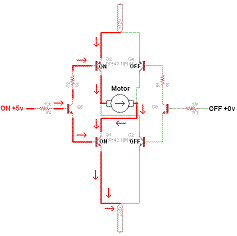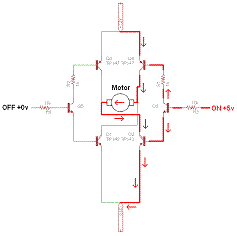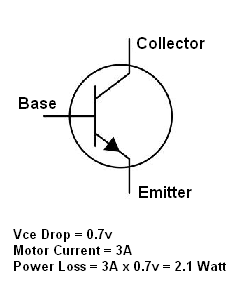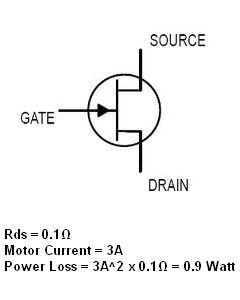The Theory
When it comes to contructing an H-bridge for DC motor control, there are two main things you need to know. First, you need to understand how the H-bridge itsself works. The next section shows you where the name comes from and how it works. The second thing you need to understand is the different types of power transistors available and when to use what type.
H-Bridge Motor Controller Theory


The two pictures seen above shows you the 2 possible modes of operation. Since there are only two digital inputs, you only ever need to turn one side on at a time. The two inputs should never be turned on at the same time, this will ruin your power transistors.
But as you can see. When we apply an 'on' +5v signal to one side of the H-bridge, it actives two transistors, allowing current to flow through the motor. This turns the motor one way. Similarly, when we activate the opposite side with an 'on' +5v signal, the other two transistors are turned on and the DC motor spins in the opposite direction.
Power Loss: BJT vs. MOSFET
When it comes to motor control and H-bridges, there's two types of power transistors that take the main stage. The Power BJT and Power MOSFET. The main difference between the two, at least as far as we are concerned is the power loss.


BJT transistors have an inherint Vce 0.7v drop, which with two transistors translates to a 1.4v drop. As you can see in the table above this amounts to about 4 Watt power loss if we're running at 3amps. That's a lot of power! The power MOSFET acts in a different way yielding a Rds 0.1Ω (some less some more) resistances across the transistor which means across two MOSFETs there is about a 2 Watt power loss.
At first glance these numbers seem not all that different, but as voltage and currents increases (+24v...+60v...) the MOSFET will win hands down with less powerloss. However, for our low voltage +12v H-bridge, these cheap TIP142/147's work nicely. There are other advantages for using BJT vs. MOSFET but I just wanted to show you this simple one. After you're an H-bridge building pro you can worry about becoming a professional designer.
When it comes to contructing an H-bridge for DC motor control, there are two main things you need to know. First, you need to understand how the H-bridge itsself works. The next section shows you where the name comes from and how it works. The second thing you need to understand is the different types of power transistors available and when to use what type.


The two pictures seen above shows you the 2 possible modes of operation. Since there are only two digital inputs, you only ever need to turn one side on at a time. The two inputs should never be turned on at the same time, this will ruin your power transistors.
But as you can see. When we apply an 'on' +5v signal to one side of the H-bridge, it actives two transistors, allowing current to flow through the motor. This turns the motor one way. Similarly, when we activate the opposite side with an 'on' +5v signal, the other two transistors are turned on and the DC motor spins in the opposite direction.
When it comes to motor control and H-bridges, there's two types of power transistors that take the main stage. The Power BJT and Power MOSFET. The main difference between the two, at least as far as we are concerned is the power loss.


BJT transistors have an inherint Vce 0.7v drop, which with two transistors translates to a 1.4v drop. As you can see in the table above this amounts to about 4 Watt power loss if we're running at 3amps. That's a lot of power! The power MOSFET acts in a different way yielding a Rds 0.1Ω (some less some more) resistances across the transistor which means across two MOSFETs there is about a 2 Watt power loss.
At first glance these numbers seem not all that different, but as voltage and currents increases (+24v...+60v...) the MOSFET will win hands down with less powerloss. However, for our low voltage +12v H-bridge, these cheap TIP142/147's work nicely. There are other advantages for using BJT vs. MOSFET but I just wanted to show you this simple one. After you're an H-bridge building pro you can worry about becoming a professional designer.